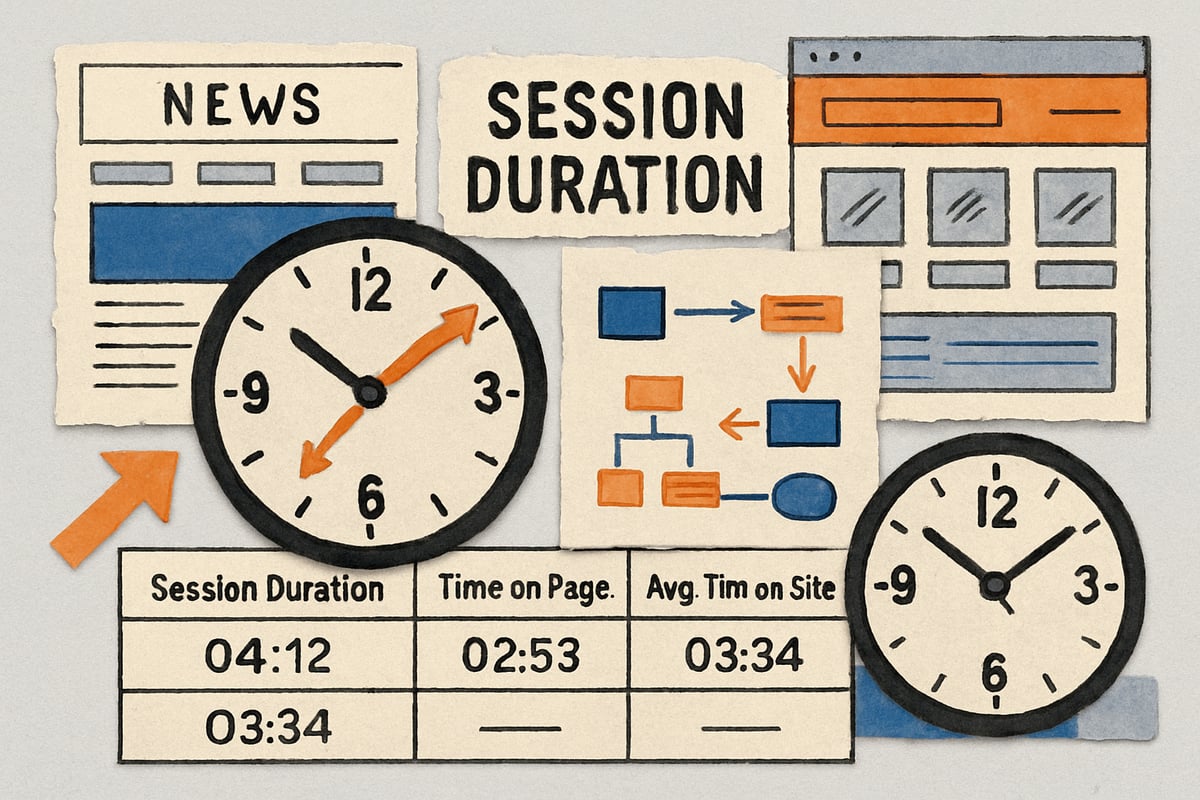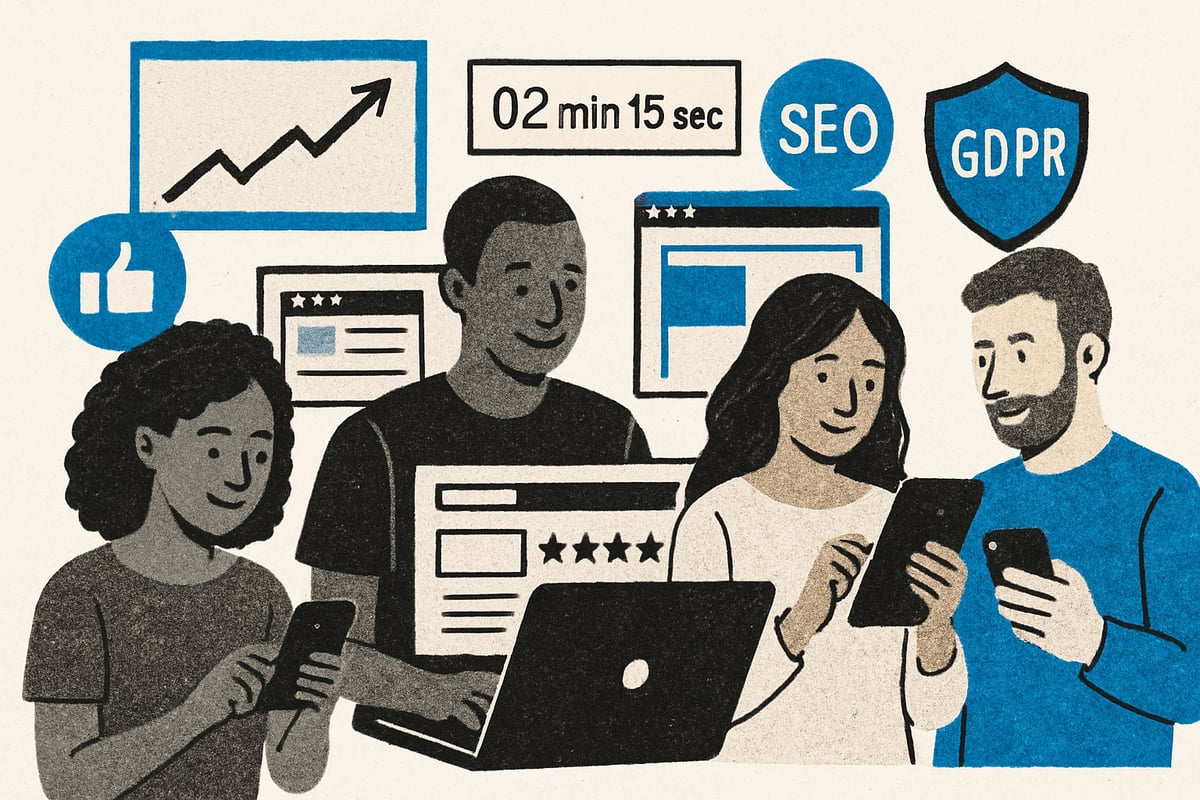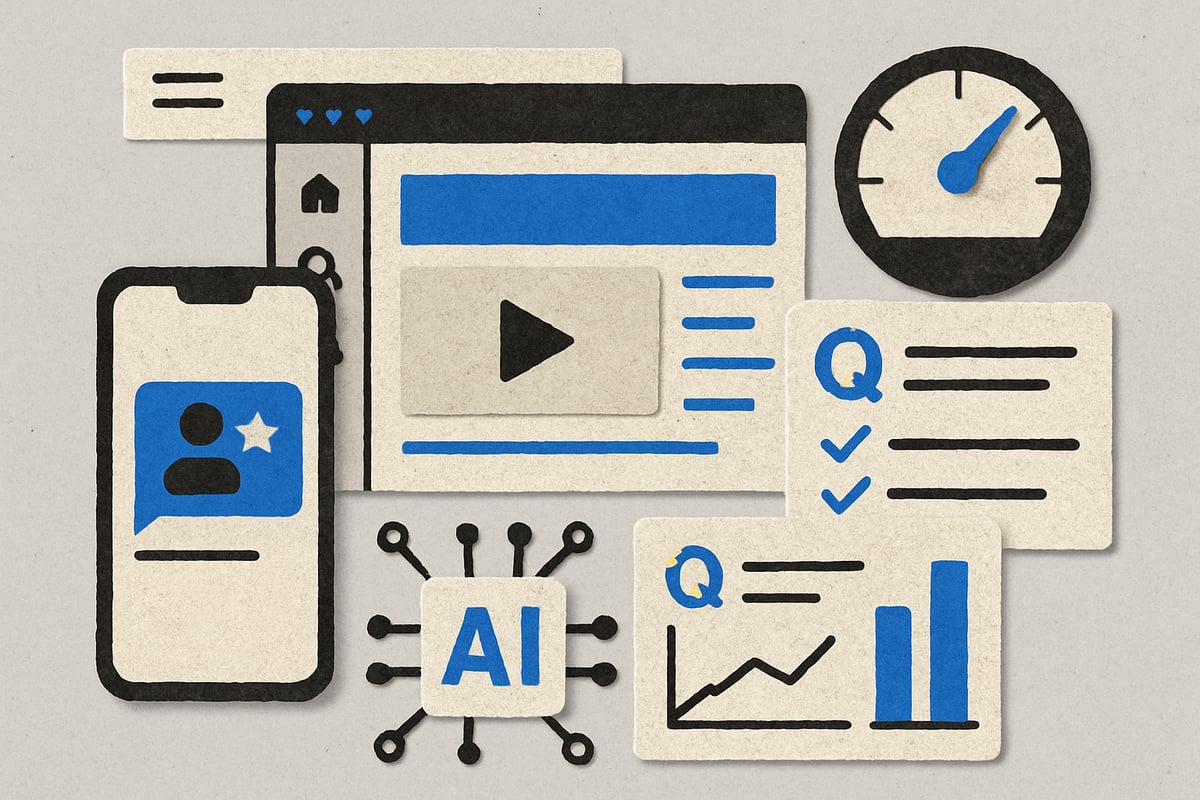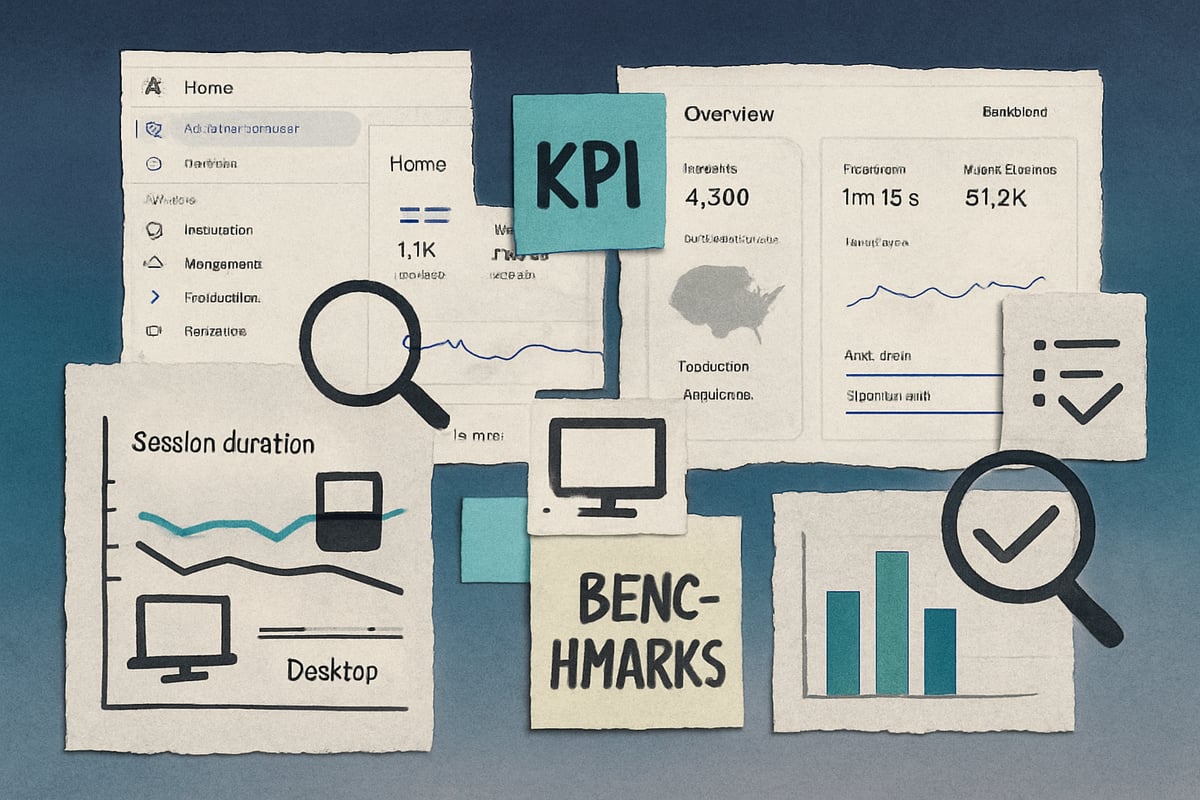- Date
Session Duration Guide: Mastering User Engagement in 2025
 Andrii Romasiun
Andrii Romasiun
Did you know your website’s future could depend on just a few minutes of user attention? In 2025, session duration is the critical metric shaping digital success, driving user engagement, SEO performance, and business growth.
This guide demystifies session duration, giving website owners and marketers the tools to master engagement. You will discover what session duration means, why it matters, how it’s measured, what influences it, proven ways to improve it, and industry benchmarks for the year ahead.
Ready to unlock powerful strategies and data-driven insights? Dive in and start mastering session duration today.
Understanding Session Duration: Definitions, Metrics, and Modern Context
Session duration is a cornerstone metric in web analytics, reflecting how long a user actively engages with your website during a single visit. As digital experiences become more immersive in 2025, understanding session duration is critical for measuring engagement and optimizing site performance.
A session begins when a user lands on your site and ends after a period of inactivity or when they leave. Session duration is calculated by summing the time spent from the first to the last interaction within a session, then dividing by the total number of sessions. This provides an average that helps gauge user interest and content effectiveness.
It’s important to distinguish session duration from similar metrics. Time on page measures how long a visitor spends on a single page, while average time on site aggregates time across all pages. Session duration encapsulates the full journey, not just isolated moments.
| Metric | Definition | Calculation Method |
|---|---|---|
| Session Duration | Total time from first to last user interaction in a session | End time - start time |
| Time on Page | Time spent on a single page | Next page time - entry |
| Average Time on Site | Combined time across all site visits divided by total visits | Total time / sessions |
The role of session duration has evolved as digital behaviors shift. In 2025, users demand faster, more personalized experiences across devices. As a result, session duration remains a vital key performance indicator, but its interpretation must adapt to changing engagement patterns and privacy standards.
However, session duration has limitations. For instance, if a user leaves your site open on the last page without further interaction, analytics platforms may not accurately capture the true end time. Single-page sessions, such as reading a blog post without clicking elsewhere, can also underreport engagement if only pageviews are tracked.
Interpreting session duration requires context. A brief session could indicate users quickly found what they needed, especially on news or FAQ sites. Conversely, a lengthy session on an e-commerce site may reflect deep product exploration or, in some cases, user confusion.
Consider these examples for clarity:
- News sites: Session duration often averages 1-2 minutes, as readers consume a single article.
- E-commerce: Sessions typically last 2-4 minutes, with users browsing multiple products.
- SaaS platforms: Longer session durations, often exceeding 5 minutes, are common due to in-depth tool usage.
Industry standards suggest that a typical session duration ranges from 2 to 3 minutes, but this varies by niche and user intent. For further details on how to measure and interpret session duration, explore this Understanding session analytics resource.
Ultimately, session duration offers valuable insights, but its true power lies in combining it with other engagement metrics and understanding the user journey unique to your website.

Why Session Duration Matters in 2025: SEO, User Experience, and Business Impact
In 2025, session duration has emerged as a central metric for anyone serious about digital growth. As users demand more relevant, seamless, and engaging experiences, understanding session duration becomes essential for evaluating how well a website meets those expectations. But what makes this metric so critical for SEO, user experience, and business outcomes?
Session duration acts as a direct reflection of user engagement. When visitors spend more time on your site, it often signals that your content is valuable, your navigation is intuitive, and your overall experience is compelling. Search engines like Google increasingly interpret these engagement signals as indicators of content quality, which can influence your rankings. In fact, longer session duration is frequently associated with improved positions in search results, since it shows users are finding what they need.
The impact of session duration extends beyond search rankings. There is a clear relationship between session duration, bounce rate, and conversion rate. Typically, longer sessions mean users are exploring more pages, interacting with features, and moving further along the conversion funnel. This also correlates with higher customer satisfaction, as users who find value are more likely to return, recommend, or make a purchase.
Let’s consider a few practical examples. E-commerce sites that monitor session duration can identify which product pages or recommendation engines keep shoppers engaged, leading to higher sales. Publishers use session duration to refine article structure, ensuring readers stay longer and consume more content. For SaaS platforms, tracking session duration helps optimize onboarding flows and in-app support, directly impacting retention.
Industry data supports these trends. According to recent research, average session duration benchmarks for 2025 hover around two to three minutes for most industries, though this varies by niche. For a deeper look at these benchmarks and actionable strategies to increase your site's session duration, see the Average Time Spent on Website: 2025 Benchmarks & Strategies.
Session duration also plays a pivotal role in shaping UX and content strategy decisions. Analyzing which pages or features lead to longer sessions helps teams prioritize updates, personalize experiences, and allocate resources for maximum impact. By using session duration as a guiding metric, businesses can create feedback loops that drive continuous improvement.
Another vital consideration for 2025 is the shift toward privacy-first analytics. As third-party cookies become obsolete and users demand more control over their data, session duration stands out as a privacy-respecting engagement metric. Modern analytics platforms now offer cookieless tracking, ensuring compliance with regulations like GDPR while still providing actionable insights.
Mobile and multi-device usage patterns further influence session duration. With more users accessing sites from smartphones and tablets, ensuring a responsive and fast experience is essential to maintaining strong engagement metrics. Adapting to these trends means businesses must monitor session duration across all platforms to stay competitive.
Ultimately, mastering session duration is about more than just keeping users on your site. It is a holistic approach to delivering value, optimizing for search, and building lasting relationships with your audience. By understanding and prioritizing session duration, organizations can unlock deeper insights, drive meaningful business results, and stay ahead in an increasingly competitive digital landscape.

Factors Influencing Session Duration: What Drives User Engagement Today?
Understanding what shapes session duration is essential for any website aiming to boost user engagement in 2025. A multitude of elements, both technical and content-driven, influence how long visitors stay on your site and the value they derive from their time spent.

Website Design, Navigation, and Session Duration
A clean, intuitive website design is the cornerstone of positive session duration. Visitors are more likely to stay and explore when navigation is logical and menus are easy to follow. Breadcrumbs, sticky headers, and effective search functions keep users oriented and reduce frustration.
Consider how different website types prioritize session duration:
| Website Type | Key Influence on Session Duration | Typical Session Duration Range |
|---|---|---|
| News | Concise articles, clear navigation | 1-3 minutes |
| E-commerce | Product discovery, recommendation | 2-5 minutes |
| SaaS | In-depth resources, user onboarding | 3-6 minutes |
A news site with rapid access to trending stories may see shorter session duration, while a SaaS platform with tutorials and resources encourages longer stays. Always ensure your design supports seamless exploration, regardless of your niche.
Content Quality, Relevance, and User Journey
Fresh, targeted, and valuable content is a powerful driver of session duration. When users find what they are searching for, they are naturally inclined to stay longer. Regularly update your site with timely articles, guides, and resources that align with user intent.
Understanding your audience’s journey is vital. If a visitor arrives with a specific goal, such as learning about a product or solving a problem, your content should guide them smoothly from entry to conversion. Strong internal linking and logical progression between topics help maintain interest and extend session duration.
Page Speed, Device Compatibility, and Mobile-First Design
Fast-loading websites are now a necessity. Studies consistently show that slow load times are a leading cause of short session duration. Compress images, minimize scripts, and leverage CDNs to ensure every page loads quickly, even on mobile connections.
Device and browser compatibility also play a critical role. Responsive design ensures your site looks and functions perfectly on smartphones, tablets, and desktops. As mobile-first browsing dominates, sites optimized for smaller screens see up to 30 percent higher session duration, underlining the importance of cross-device consistency.
Multimedia, Interactivity, and Personalization
Multimedia and interactive elements are proven to increase session duration by capturing and holding user attention. Videos, infographics, quizzes, and calculators provide dynamic ways for users to engage with your content. For example, interactive tools can boost session duration by up to 50 percent.
Personalization takes engagement a step further. AI-driven content recommendations or product suggestions based on user behavior create tailored experiences that keep visitors coming back. E-commerce sites using these techniques often report significant gains in both session duration and overall user satisfaction.
Actionable Strategies and Common Pitfalls
Improving session duration demands a holistic approach. Focus on site speed, intuitive navigation, high-quality content, and engaging features. However, be mindful that a long session duration is not always positive if users are stuck or confused. Always analyze session duration alongside bounce rates and conversions for a complete picture.
For a deeper dive into proven tactics, see our Ultimate website optimisation guide, which offers actionable steps to enhance all key engagement metrics, including session duration.
How to Analyze and Benchmark Session Duration in 2025
Understanding how to analyze and benchmark session duration is essential for optimizing user engagement in 2025. This process involves more than simply tracking numbers. It requires a comprehensive approach that combines the right analytics tools, data segmentation, benchmarking, and continuous feedback to drive meaningful improvements.

Step-by-Step Guide to Tracking Session Duration
Begin by selecting a robust analytics platform. In 2025, Google Analytics 4 (GA4) and privacy-first tools are the leading solutions for tracking session duration. Set up your analytics account and ensure all tracking codes are properly implemented across your website.
Next, navigate to the engagement or session reports within your chosen platform. Here, you will find detailed metrics on session duration, including averages and distributions. Review these reports regularly to spot trends and anomalies.
Remember, accurate session duration measurement depends on correct configuration. Double-check that your tracking settings capture all relevant user interactions and that your reporting time zones match your business operations.
Segmenting and Supplementing Session Duration Data
To gain deeper insights, segment your session duration data by device type, source or medium, user type (new vs returning), and geography. This helps identify which audiences are most engaged and where optimization opportunities exist.
For even greater detail, supplement your session duration analysis with event tracking. By monitoring specific actions such as clicks, video plays, or form submissions, you can uncover what keeps users engaged during their sessions. For a practical approach, refer to this Guide to event tracking, which explains how custom events provide context to session duration and reveal hidden engagement patterns.
Combine these segmentation techniques with event data to build a comprehensive picture of user behavior. This layered analysis is vital for detecting friction points and enhancing the overall user journey.
Benchmarking Against Industry Standards and Competitors
Benchmarking your session duration against industry standards and competitors provides valuable context. In 2025, average session duration benchmarks vary by sector. For example, news sites typically see 2-3 minutes, while SaaS and e-commerce platforms often report higher averages.
Create a simple table to compare your site’s session duration over time and against industry averages:
| Segment | Your Site | Industry Avg |
|---|---|---|
| News | 2:10 | 2:30 |
| E-commerce | 3:45 | 3:20 |
| SaaS | 4:30 | 4:00 |
Regularly review your historical data to identify trends and set realistic targets. Use competitor analysis tools to research how leading sites in your niche perform and what engagement strategies they employ.
Setting Goals, Validating Insights, and Using Feedback Loops
Set data-driven goals for session duration improvement based on your benchmarking results. Segment your targets by device and audience type for greater precision. For instance, if mobile users have shorter sessions, prioritize mobile optimization.
Always validate quantitative findings with qualitative feedback. Conduct user surveys, usability tests, and interviews to understand the reasons behind session duration trends. These feedback loops help you connect the data to real user experiences.
As an example, segmenting session duration by device might reveal that desktop users engage longer, prompting a review of your mobile UX. Continuous monitoring, testing, and adaptation ensure your efforts are aligned with evolving user expectations and industry trends.
Step-by-Step: How to Improve Session Duration and Master User Engagement
Driving longer session duration is about creating a seamless, valuable, and engaging experience for every visitor. By following these actionable steps, you can boost your session duration and unlock deeper user engagement, regardless of your industry or website type.
1. Optimize Website Speed and Performance
A fast website is the cornerstone of extended session duration. Visitors expect instant access, so delays can quickly drive them away.
- Compress all images before uploading.
- Use a content delivery network for global speed.
- Minimize and defer non-essential scripts.
Tools like Google PageSpeed Insights or real user monitoring help pinpoint bottlenecks. Competitor data confirms that slow load times are a leading cause of short session duration, making site speed a top priority for engagement.
2. Enhance Website Design and Navigation
Intuitive layouts encourage users to explore more content, directly impacting session duration.
- Keep menus logical and easy to follow.
- Add sticky headers for quick access to navigation.
- Include breadcrumbs so users never feel lost.
A well-organized site with clear pathways ensures users spend more time discovering what you offer. Sites that revamp their navigation often see measurable increases in session duration.
3. Improve Content Quality and Relevance
High-quality, relevant content is essential for keeping users engaged, which naturally lengthens session duration.
- Update content regularly to reflect user needs and trends.
- Write in clear, concise language with engaging headlines.
- Incorporate visuals and multimedia for added value.
Blogs that publish in-depth, timely guides consistently report longer session duration. Focus on matching your content to user intent to maximize engagement.
4. Create a Mobile-Friendly, Responsive Experience
More than half of web traffic now comes from mobile devices, making mobile optimization crucial for maximizing session duration.
- Use responsive design to ensure your site looks great on every device.
- Optimize buttons and forms for touch interactions.
- Test across browsers for consistent performance.
Data shows that mobile-optimized sites see up to 30% higher session duration on average. Prioritize the mobile experience to reach and retain a wider audience.
5. Incorporate Multimedia and Interactive Elements
Dynamic content like videos, infographics, and interactive tools can dramatically increase session duration.
- Embed short, relevant videos to illustrate key points.
- Add quizzes or calculators for hands-on engagement.
- Ensure all media is compressed for fast loading.
Interactive tools have been shown to increase session duration by up to 50%. These elements keep users active and interested throughout their visit.
6. Implement Personalization and Smart Recommendations
Personalized experiences encourage deeper exploration, leading to higher session duration.
- Use AI-driven engines to suggest related content or products.
- Customize calls to action based on user behavior.
- Display recommendations at logical points in the user journey.
E-commerce platforms that deploy smart recommendation engines often see significant lifts in session duration and overall engagement.
7. Reduce Bounce Rates and Guide User Flow
Reducing bounce rate is closely linked to boosting session duration. Guide users naturally from one page to the next.
- Match landing page content to user expectations.
- Use internal links and clear calls to action.
- Highlight related articles or products.
A 10% reduction in bounce rate can result in a 15% increase in session duration. Align content and navigation with user intent for the best results.
8. Make A/B Testing and Continuous Improvement a Habit
Optimization is never finished. Regular A/B testing is key to sustained growth in session duration.
- Test headlines, layouts, and CTAs to see what works best.
- Use session duration as a core metric for evaluating changes.
- Implement feedback loops, such as user surveys or session recordings.
For the latest trends and insights on engagement optimization, reference the Latest Google Analytics 4 (GA4) Statistics for 2025 to benchmark your session duration and discover how leading brands are adapting.
Session Duration Benchmarks, Trends, and Future Outlook
Understanding where your session duration stands compared to industry peers is essential for setting realistic goals and tracking progress. As user expectations evolve, benchmarks for session duration have shifted across sectors, reflecting new standards for engagement and digital strategy.
Below is a comparison of average session duration benchmarks by industry for 2025:
| Industry | Average Session Duration (2025) |
|---|---|
| News/Media | ~2 minutes |
| E-commerce | 2.5–3.5 minutes |
| SaaS (B2B) | 4+ minutes |
| Education | 3–4 minutes |
| Finance | 2–3 minutes |
These figures are supported by recent customer engagement metrics, which highlight that session duration varies according to content depth and user intent. For instance, news sites typically see shorter sessions, while SaaS platforms attract users for longer, task-oriented visits.
Looking ahead, several key trends are shaping how session duration is measured and optimized:
- Artificial intelligence is transforming content delivery, personalizing experiences to keep users engaged longer.
- Voice search and multi-device journeys are changing the way users interact with websites, impacting session duration data.
- Privacy regulations and the decline of third-party cookies require a shift to first-party, ethical analytics solutions.
As analytics platforms adapt, businesses must consider the limitations and opportunities of session duration. The move toward privacy-first measurement is accelerating, with platforms offering transparent, cookieless tracking and data ownership. For more on this trend, explore this privacy-friendly analytics overview.
To stay competitive, organizations should adjust their session duration benchmarks regularly. Factors such as evolving user expectations, mobile-first design, and content innovation play a vital role in shaping what constitutes a "good" session duration for your niche.
Here are key strategies for future-proofing your approach:
- Monitor industry trends and update your benchmarks annually.
- Segment session duration by device, user type, and acquisition channel.
- Invest in privacy-compliant analytics that provide actionable insights while respecting user rights.
- Use feedback loops and A/B testing to refine engagement strategies.
In 2025 and beyond, session duration will remain a cornerstone metric for digital success. By embracing new technologies, adapting to privacy demands, and benchmarking against industry leaders, you can ensure your website continues to engage and convert users effectively.
As you’ve seen throughout this guide, understanding and optimizing session duration is more important than ever for user engagement and business growth in 2025. If you want to put these strategies into action with confidence, why not use a platform that’s built for privacy, transparency, and deep insights? With Swetrix, you get real time, cookie free analytics that respect your users and empower you with the data you need—all while staying fully GDPR compliant. Ready to see how ethical analytics can transform your engagement metrics? Try Swetrix today and start mastering your website’s user experience.